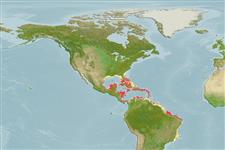Common names from other countries
>
Eupercaria/misc (Various families in series Eupercaria) >
Sciaenidae (Drums or croakers)
Etymology: Equetus: Latin, eques, -itis = horse, man in a horse, chevalier .
More on authors: Bloch & Schneider.
Environment: milieu / climate zone / depth range / distribution range
Ecologie
marien rifbewoner; diepte 3 - 30 m (Ref. 9710). Tropical; 36°N - 24°S, 98°W - 28°W
Western Atlantic: Bermuda, Florida (USA), and Bahamas to the Antilles (Ref. 26340) and Yucatan (Mexico) (Ref. 26938) to Brazil.
Grootte / Gewicht / Leeftijd
Maturity: Lm ? range ? - ? cm
Max length : 27.0 cm TL mannelijk / geslacht onbekend; (Ref. 26340); common length : 18.0 cm TL mannelijk / geslacht onbekend; (Ref. 5217)
Dorsale stekels (totaal) : 11 - 13; Dorsale zachte stralen (totaal) : 45 - 47; Anale stekels: 2; Anale zachte stralen: 6 - 8. First dorsal fin very high with short base. Second dorsal and caudal fins dark with white spots and dashes (Ref. 26938). Head white with two dark brown bars, one through eye, the other more posterior and more diagonal, extending across chest to pelvic fins; body white with a broad dark brown band beginning on front of first dorsal fin, curving across nape, above pectoral fin, and running to mid-base of caudal fin; two narrower dark stripes above and below this band (Ref. 13442). Mouth small, inferior, nearly horizontal. Spinous dorsal fin very elevated, higher than head length. Gas bladder simple, carrot-shaped without appendages. Sagitta (large earstone) near rounded and thick (Ref 51721).
Occurs primarily on coral reefs. Secretive and usually solitary, under ledges or near small caves (Ref. 7251). Often seen during the day around the bases of corals (Ref. 26938). Feeds at night on crabs, shrimps, and polychaetes. Easily approached (Ref. 9710). Has been reared in captivity (Ref. 35420).
Levenscyclus en paargedrag
Maturities | Voortplanting | Spawnings | Egg(s) | Fecundities | Larven
Robins, C.R. and G.C. Ray, 1986. A field guide to Atlantic coast fishes of North America. Houghton Mifflin Company, Boston, U.S.A. 354 p. (Ref. 7251)
Status op de Rode Lijst van het IUCN (Ref. 130435)
CITES (Ref. 128078)
Not Evaluated
Gevaar voor de mens
Reports of ciguatera poisoning (Ref. 30303)
Gebruik door de mens
Visserij: van minder commercieel belang; Aquarium: Commercieel
Tools
Speciale rapporten
Download XML
Internetbronnen
Estimates based on models
Preferred temperature (Ref.
115969): 26.3 - 28.2, mean 27.4 (based on 675 cells).
Fylogenetische diversiteitsindex (Ref.
82804): PD
50 = 0.7500 [Uniqueness, from 0.5 = low to 2.0 = high].
Bayesian length-weight: a=0.00851 (0.00413 - 0.01752), b=3.08 (2.91 - 3.25), in cm Total Length, based on LWR estimates for this (Sub)family-body shape (Ref.
93245).
Trofisch niveau (Ref.
69278): 3.5 ±0.3 se; based on diet studies.
Weerstandsvermogen (Ref.
120179): Hoog, minimale populatieverdubbelingstijd minder dan 15 maanden (Preliminary K or Fecundity.).
Fishing Vulnerability (Ref.
59153): Low vulnerability (17 of 100).
